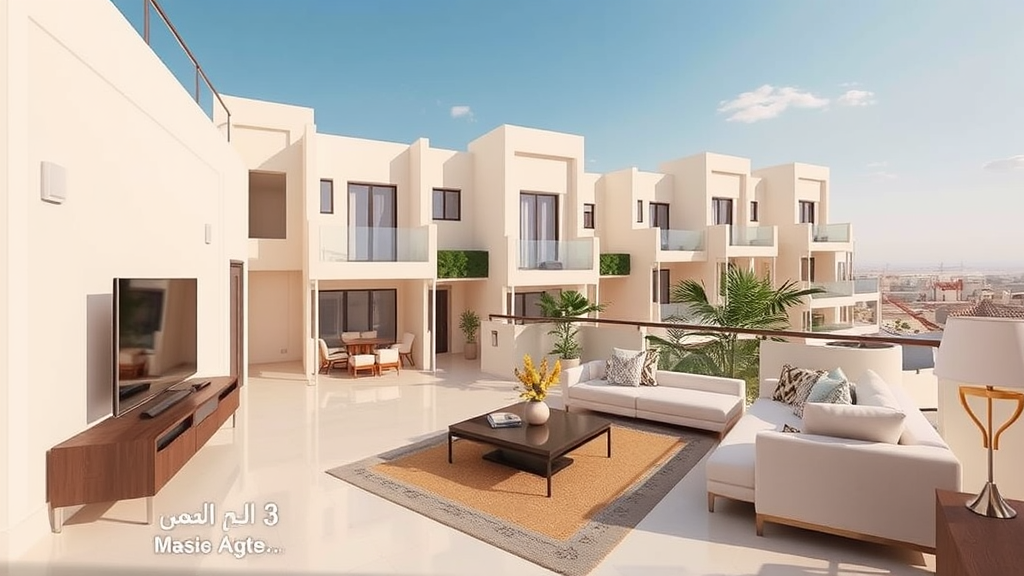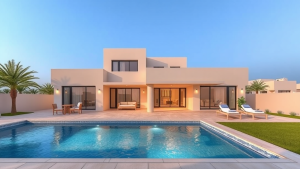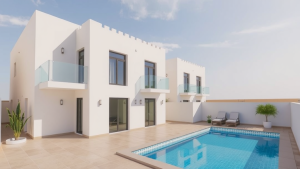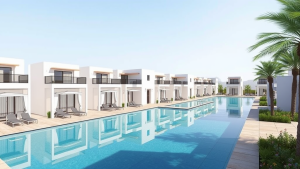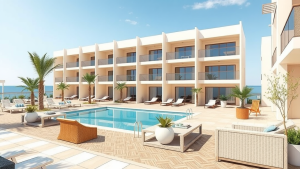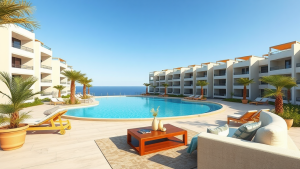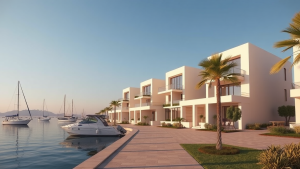The role of vision 2030 projects in lowering living costs in Hurghada
The Vision 2030 initiative is reshaping many aspects of life in Hurghada, aiming to enhance the quality of living while keeping costs manageable for residents. With a focus on sustainability and economic diversification, these projects are instrumental in stabilizing living costs and fostering a healthy community. Here’s a closer look at the impact of Vision 2030 projects on the living costs in this vibrant coastal city.
Infrastructure development
One of the most direct ways Vision 2030 projects help lower living costs in Hurghada is through extensive infrastructure development. Improved roads, public transportation, and utilities support local businesses and provide residents easier access to essential services. Here’s how:
- Enhanced Transportation: With upgraded public transit systems, residents can enjoy cheaper and more reliable travel options, reducing the need for private vehicles.
- Better Access to Services: Better road networks mean easier access to health care, education, and employment opportunities, translating to lower overall living expenses.
Tourism and economic growth
The tourism sector is a significant contributor to Hurghada’s economy. Vision 2030 aims to diversify tourism offerings to stabilize income and create job opportunities. This approach helps keep living costs low by:
- Job Creation: More tourism means more jobs, leading to higher household incomes. With more money in circulation, residents can better manage their daily expenses.
- Year-Round Visitors: By attracting visitors beyond the traditional peak season, businesses can maintain steady revenue, minimizing fluctuations in prices for goods and services.
Affordable housing initiatives
As part of Vision 2030, the government aims to enhance housing initiatives by developing affordable housing projects. This step directly impacts living costs in a few ways:
- Reduced Rent: With more affordable housing options available, rental prices are kept in check, alleviating financial pressure on families.
- Home Ownership: Programs aimed at increasing homeownership give residents a stake in their community, resulting in long-term financial stability.
Support for local businesses
Another crucial aspect of Vision 2030 involves supporting local businesses through grants and training programs. This support can lead to lower living costs in Hurghada through:
- Increased Competition: With more local businesses, prices become more competitive, benefitting consumers who are looking for affordable options.
- Community Investments: Stimulating local economies helps ensure that wealth stays within the community, allowing residents to enjoy more reasonable prices on goods and services.
Sustainability efforts
Vision 2030 also incorporates sustainability-focused projects aimed at reducing living costs in the long run. Here’s how sustainability can make a difference:
- Energy Efficiency: Initiatives promoting solar energy use and other renewable resources help lower utility bills for residents, creating a more affordable and sustainable lifestyle.
- Waste Management: Improvements in waste management practices lead to cleaner neighborhoods and reduce cleaning costs, benefiting everyone.
As Hurghada embraces the Vision 2030 initiatives, residents can expect positive changes in their daily lives. These comprehensive projects not only focus on immediate benefits but also aim for long-term sustainability and stability in living costs. From enhanced infrastructure to greater support for local businesses, the impacts are far-reaching, allowing residents to enjoy a higher quality of life without the burden of rising expenses. Investing in future-ready solutions paves the way for a resilient economy and a more affordable living environment for everyone in Hurghada.
How infrastructure development influences economic stability in coastal cities
In coastal cities, infrastructure development serves as a linchpin for economic stability and growth. Roads, bridges, public transport systems, and essential utilities enable smoother operations in businesses and enhance the quality of life for residents. By creating a robust infrastructure framework, coastal cities can attract investment, generate jobs, and improve the overall economic landscape.
One of the primary ways that infrastructure influences economic stability is through enhanced connectivity. When coastal cities invest in better roads and transport links, they open new avenues for trade and tourism. This is particularly essential for cities like Hurghada, where the economy heavily relies on tourism. Improved roadways facilitate access to beaches, hotels, and attractions, ensuring that visitors can enjoy their stay without obstacles.
Furthermore, reliable public transport can encourage more local and international tourists, leading to increased revenue for businesses. For residents, it means easier commutes to work, more job opportunities, and better access to essential services, which contributes to a more stable economy.
In addition to enhancing mobility, infrastructure development leads to job creation. Projects such as building new schools, hospitals, and transportation systems require a workforce. This influx of employment opportunities reduces unemployment rates in coastal cities and can stimulate economic activities in surrounding areas. The economic ripple effect generated by these projects sustains local businesses and elevates living standards.
Investment in utilities is another vital aspect of infrastructure development. Reliable electricity, water supply, and waste disposal systems are essential for supporting both residential and commercial activities. In regions where utilities are lacking or unreliable, economic activities can stall. By ensuring that these basic needs are met, coastal cities can create an environment conducive to growth.
Furthermore, with significant investments in renewable energy infrastructure, coastal cities can work towards sustainability while cutting operational costs for businesses. This not only attracts eco-conscious investors but also reduces the financial burden on local residents. For instance, solar energy initiatives can lead to lower energy costs and demonstrate economic foresight in a climate-conscious world.
It’s important to consider how infrastructure affects different sectors. The fishing and shipping industries are directly reliant on well-maintained ports. When ports are modernized and expanded, they can accommodate larger vessels and improve the efficiency of cargo handling. This boosts trade operations and creates further economic opportunities within the community.
In many coastal cities, tourism acts as a cornerstone of the economy. Infrastructure improvements that enhance the tourist experience—like better airports or improved coastal pathways—draw more visitors. This boom in tourism generates extra income for local businesses and cultivates a sustained economic ecosystem. For instance, enhanced visitor amenities can contribute to longer stays and increased expenditure.
On a broader scale, infrastructure development can also support technological advancements. Coastal cities that invest in high-speed internet and smart city technologies create environments that attract tech startups and innovators. This influx of businesses not only diversifies the local economy but also leads to high-paying job opportunities, stabilizing the economic landscape significantly.
In terms of planning and development, it’s vital for local governments and stakeholders to prioritize community needs. Engaging residents in discussions about project developments can lead to more targeted and effective infrastructure initiatives. When people see that their concerns are being considered, it fosters community spirit and collaboration, driving further support for economic growth.
- **Enhanced Connectivity**: Improved roads and transport systems facilitate trade and tourism.
- **Job Creation**: Infrastructure projects generate employment opportunities, reducing unemployment rates.
- **Utility Investments**: Reliable internet, electricity, and water support residential and commercial activities.
- **Sustainable Development**: Investments in renewable energy can reduce costs and attract eco-focused investments.
- **Tourism Boost**: Infrastructure improvements enhance the overall tourist experience, increasing local revenue.
- **Tech Prosperity**: Modern technology infrastructure attracts startups and innovators, diversifying the economy.
To sum up, infrastructure development is not just about building physical structures; it’s a strategic approach to ensuring long-term economic stability in coastal cities. By understanding the multifaceted benefits and focusing on community needs, local leaders can create a solid foundation for a thriving economy that influences every aspect of life.
Vision 2030 projects stand as a beacon of hope for the residents of Hurghada, demonstrating a clear pathway to lower living costs. By focusing on targeted improvements in infrastructure, these projects are not just enhancing the physical layout of the city but also contributing significantly to the economic well-being of its inhabitants. Improved transportation routes, better utility services, and upgraded amenities are more than just conveniences; they are vital components that lead to a more stable economy.
As infrastructure develops, local businesses thrive, leading to job creation and economic diversification. This, in turn, results in more competitive pricing for goods and services, directly benefiting residents concerned about rising living expenses. A stable economy in coastal cities like Hurghada ensures that both locals and tourists can enjoy the area without the worry of inflation diminishing their purchasing power.
Moreover, by attracting investment and tourism through well-planned projects, Vision 2030 is creating an environment where employment and opportunities can flourish. The positive ripple effects are evident, from reduced unemployment rates to improved quality of life, all contributing to a more affordable living situation.
Ultimately, the commitment to Vision 2030’s initiatives not only reshapes the landscape of Hurghada but also secures a sustainable future for its residents. As effective measures align with community needs, the vision of a thriving, affordable, and welcoming city becomes a reality for all. Embracing these changes means embracing a brighter, more stable future for Hurghada and its inhabitants.
16% off – spacious 4 bedroom town house for sale in al kawther Hurghada under 200k — properties for british surfers
Last offer – 5 bedroom penthouse for sale with balcony in Al Ahyaa Hurghada under 200k — luxury homes for british digital nomads

